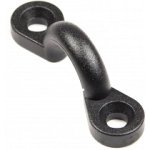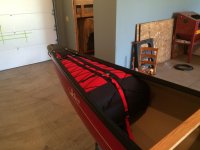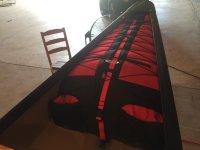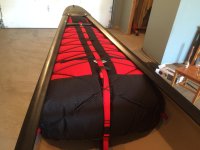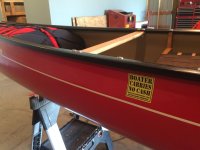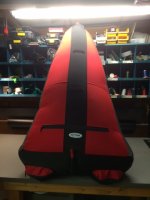So I guess this is my response to Alan's question about what is going on in my shop (garage) this winter. Outfitting the new boat.
The Prospector is made of Tuffweave and although I asked Wenonah where I should install the rivet/lashing kit, a friend who has a Kevlar Wenonah also did so in a separate email and we received two different responses.
We plan on riveting the padded loops (pic below) to the inside of the canoe so the lashings and bags can be easily removed.
Typical options are to rivet the lashing kit through the gunwales, just under it or about an inch under it. I was told, with either Kevlar or Tuffweave, to mount the kit just under the gunwale. My friend was told to mount it through the gunwale on either boat.
Gunwales are there to stabilize the structure of the boat and my concern is that riveting through aluminum gunwales will in some way weaken them. Apparently there isn't much maintenance that needs to happen with them so that shouldn't be the issue (So I was told).
Riveting just under the gunwale makes sense to me, but the idea of a rivet getting pulled through the hull (someone grabs the lashings to carry the boat or in a rescue situation) is enough to wake me up at 3AM. I thought about adding a strip of flashing of some kind on the inside the hull (single strip that all rivets pass through, might possibly 'share the load' more evenly) but haven't been able to come up with a suitable material (aluminum might be to sharp, etc) that might make that feasible.
So, please weigh in - all suggestions and ideas are welcome!
Thanks - Kathy
The Prospector is made of Tuffweave and although I asked Wenonah where I should install the rivet/lashing kit, a friend who has a Kevlar Wenonah also did so in a separate email and we received two different responses.
We plan on riveting the padded loops (pic below) to the inside of the canoe so the lashings and bags can be easily removed.
Typical options are to rivet the lashing kit through the gunwales, just under it or about an inch under it. I was told, with either Kevlar or Tuffweave, to mount the kit just under the gunwale. My friend was told to mount it through the gunwale on either boat.
Gunwales are there to stabilize the structure of the boat and my concern is that riveting through aluminum gunwales will in some way weaken them. Apparently there isn't much maintenance that needs to happen with them so that shouldn't be the issue (So I was told).
Riveting just under the gunwale makes sense to me, but the idea of a rivet getting pulled through the hull (someone grabs the lashings to carry the boat or in a rescue situation) is enough to wake me up at 3AM. I thought about adding a strip of flashing of some kind on the inside the hull (single strip that all rivets pass through, might possibly 'share the load' more evenly) but haven't been able to come up with a suitable material (aluminum might be to sharp, etc) that might make that feasible.
So, please weigh in - all suggestions and ideas are welcome!
Thanks - Kathy
Attachments
Last edited:

